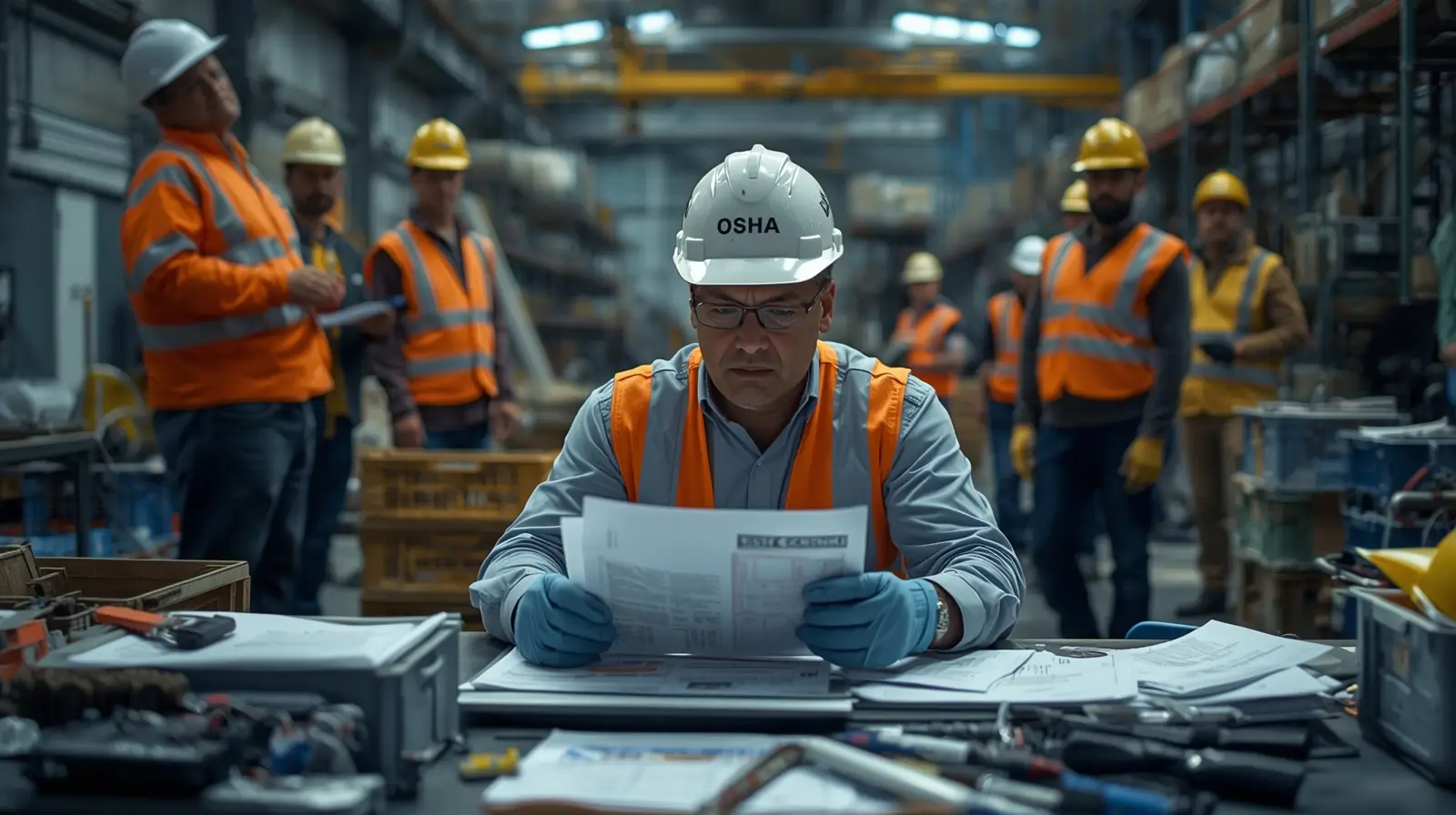The Occupational Safety and Health Administration (OSHA) is a vital federal agency within the U.S. Department of Labor that ensures safe and healthy working conditions for employees across the nation.
Since its establishment in 1971 under the Occupational Safety and Health Act, OSHA has developed and enforced workplace safety standards, provided education and training, and supported both employers and employees in maintaining adherence.
Its work has significantly reduced workplace injuries, illnesses, and fatalities across multiple industries.
What is OSHA?
The Occupational Safety and Health Administration (OSHA) is a U.S. federal agency under the Department of Labor.
It was established in 1970 to ensure safe and healthy working conditions for employees.
OSHA sets and enforces safety standards, provides training, and assists employers and workers in maintaining hazard-free workplaces.
Its mission is to protect the well-being of every worker across the nation.
What is the main purpose of OSHA?
The main purpose of OSHA is to prevent workplace injuries, illnesses, and fatalities by enforcing safety standards. It achieves this through inspections, training, and education programs for both employers and employees.
OSHA also encourages businesses to create proactive safety cultures rather than reacting to accidents. Its ultimate goal is to make every workplace as safe as possible.
Who does OSHA protect?
OSHA protects most private-sector workers and employers in the United States. This includes employees in industries such as manufacturing, healthcare, construction, and retail.
It also covers federal government workers and some state or local employees under approved state plans. Essentially, OSHA’s coverage extends to millions of workers across diverse sectors.
Which industries are covered under OSHA regulations?
Almost every major industry in the U.S. falls under OSHA’s jurisdiction. These include construction, general industry, maritime, agriculture, and healthcare.
OSHA tailors its safety standards to address specific risks in each sector, for example, fall protection in construction or infection control in healthcare. By doing so, it ensures relevant and practical safety enforcement.
Are there any workplaces not covered by OSHA?
Certain workplaces are not directly covered by OSHA. These include self-employed individuals, family-run farms without outside employees, and workers governed by other federal safety laws, such as miners or transportation employees. Additionally, some public-sector workers may be covered by state-level safety programs instead of federal OSHA. However, OSHA still supports those states through cooperative agreements.
What are employers required to do under OSHA law?
Under OSHA law, employers must provide a workplace free from recognized hazards. They are required to comply with OSHA safety and health standards, display official OSHA posters, and maintain records of work-related injuries.
Employers must also train employees about potential risks in a language they understand. Regular inspections and safety policies are part of maintaining adherence.
What rights do employees have under OSHA?
Employees have the right to a safe and healthy workplace under OSHA. They can report unsafe conditions, request inspections, and participate in OSHA investigations without fear of retaliation.
Workers also have the right to access medical records, exposure data, and information about workplace hazards. These rights empower employees to take an active role in workplace safety.
How does OSHA enforce workplace safety laws?
OSHA enforces safety laws through inspections, investigations, and penalties. Its adherence officers visit worksites to evaluate whether employers are meeting OSHA standards.
When violations are found, OSHA can issue citations and require corrective actions. The agency also offers consultation and training to help businesses comply before enforcement becomes necessary.
What happens during an OSHA inspection?
During an OSHA inspection, an adherence officer reviews workplace conditions, safety programs, and records. The visit usually begins with an opening conference followed by a walkaround to identify potential hazards.
Employees may be interviewed about safety practices. Afterward, the officer conducts a closing conference to discuss findings and possible violations.
How does OSHA determine fines and penalties?
Fines and penalties depend on the severity, type, and frequency of violations. OSHA classifies them as serious, willful, or repeated violations, with higher penalties for those showing disregard for worker safety.
Penalties are designed to motivate employers to correct hazards promptly. In some cases, OSHA may reduce fines if employers demonstrate good faith efforts to comply.
What is the difference between OSHA 10 and OSHA 30 training?
OSHA 10-hour and OSHA 30-hour trainings are both part of OSHA’s outreach program. The 10-hour course is designed for entry-level workers, covering basic safety and health topics.
The 30-hour course, intended for supervisors or safety managers, provides deeper insights into hazard recognition, prevention, and management. Both certifications promote a safer work culture.
How can workers file a complaint with OSHA?
Workers can file a complaint with OSHA if they believe their workplace is unsafe or violates standards. Complaints can be submitted online, by mail, or over the phone.
OSHA treats all complaints seriously and may follow up with an inspection. Employees can choose to have their identity kept confidential during the process.
Can workers report hazards anonymously?
Yes, OSHA allows workers to report unsafe conditions anonymously. This protection ensures employees can speak up without fear of retaliation from their employer.
Anonymity encourages workers to report potential hazards early before they cause harm. OSHA then investigates the complaint and takes necessary action to ensure safety adherence.
What should employers do if they receive an OSHA citation?
If employers receive an OSHA citation, they must correct the violations within the specified timeframe. They can also request an informal conference with OSHA to discuss or contest the citation.
Employers should use this opportunity to understand the findings and demonstrate their commitment to safety improvements. Prompt corrective actions help prevent future incidents.
How does OSHA support small businesses?
OSHA offers free consultation programs and adherence assistance tailored for small businesses. These services help identify workplace hazards and suggest cost-effective safety solutions.
The consultations are separate from enforcement, meaning no citations or penalties are issued. This approach encourages small businesses to strengthen safety practices voluntarily.
How does OSHA collaborate with state safety programs?
OSHA partners with state agencies through state plans that align with federal standards. States that run their own OSHA-approved programs must maintain enforcement as effective as federal OSHA.
This collaboration allows states to address local industries or unique safety challenges more effectively. Federal OSHA continues to provide guidance and oversight.
What is the difference between federal OSHA and state OSHA plans?
Federal OSHA directly enforces safety laws in most states, while some states operate their own OSHA-approved plans.
State OSHA plans cover both private and public sector workers, offering flexibility to adapt to local needs. However, they must still meet or exceed federal OSHA requirements.
This dual system ensures consistent protection across the nation.
Why is OSHA training important even if it’s not mandatory?
OSHA training equips workers with the knowledge to recognize and prevent workplace hazards. Even when not required, such training reduces accidents, increases confidence, and promotes accountability.
Employers also benefit from fewer injuries and better adherence records. A well-trained workforce is the foundation of a safe and productive workplace.
How does OSHA contribute to reducing workplace accidents and fatalities?
Through enforcement, education, and outreach, OSHA has significantly reduced workplace injuries and deaths since its creation.
Its safety programs, regular inspections, and reporting systems promote awareness and prevention.
By holding employers accountable, OSHA ensures safer conditions for millions of workers. Continuous training and adherence help sustain these improvements long-term.
How can both employers and workers stay compliant with OSHA standards?
Employers and employees can stay compliant by regularly reviewing OSHA standards relevant to their industry.
Ongoing safety training, updated policies, and regular hazard assessments are key. Employers should maintain documentation and encourage open communication about safety.
Workers should report hazards promptly and follow established safety protocols.
Where can you learn more about OSHA or take OSHA-authorized training?
To learn more about OSHA standards and get certified training, visit OSHAOutreachCourses.com. The platform offers OSHA-authorized 10-hour and 30-hour courses for various industries.
It’s a trusted resource for individuals and organizations looking to enhance workplace safety knowledge. Taking these courses can help create a safer, more compliant work environment.
Conclusion
OSHA plays a crucial role in ensuring that every worker returns home safe and healthy at the end of the day.
Its standards, inspections, and training programs have built a foundation of accountability and awareness in workplaces nationwide.
By promoting safety education and enforcing adherence, OSHA continues to reduce preventable injuries and fatalities.
Whether you’re an employer or an employee, understanding OSHA’s role and following its guidelines benefits everyone.
To take the next step toward a safer workplace, consider enrolling in an authorized course through OSHAOutreachCourses.com.










